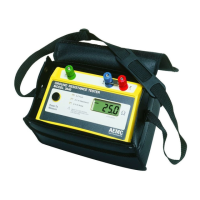14
Digital Ground Resistance Tester Model 3640 and 4610
C) Theonlycomponentremainingistheresistanceofthesurround-
ingearth.Theelectrodecanbethoughtofasbeingsurrounded
by concentric shells of earth or soil, all of the same thickness.
The closer the shell to the electrode, the smaller its surface;
hence,thegreateritsresistance.Thefartherawaytheshellsare
fromtheelectrode,thegreaterthesurfaceoftheshell;hence,the
lowertheresistance.Eventually,addingshellsatadistancefrom
thegroundingelectrodewillnolongernoticeablyaffecttheoverall
earthresistancesurroundingtheelectrode.Thedistanceatwhich
thiseffectoccursisreferredtoastheeffectiveresistanceareaand
isdirectlydependentonthedepthofthegroundingelectrode.
Intheory,thegroundresistancemaybederivedfromthegeneral
formula:
R =
ρ
Resistance=Resistivityx
L
A
Length
Area
Thisformulaclearlyillustrateswhytheshellsofconcentricearth
decreaseinresistancethefarthertheyarefromthegroundrod:
R=ResistivityofSoilx
ThicknessofShell
Area
Inthecaseofgroundresistance,uniformearth(orsoil)resistivitythrough-
outthevolume is assumed,although thisis seldomthe casein nature.
The equations for systems of electrodes are very complex and often
expressedonlyasapproximations.Themostcommonlyusedformulafor
singlegroundelectrodesystems,developedbyProfessorH.R.Dwightof
theMassachusettsInstituteofTechnology,follows:
R =
ρ
2πL
{(In 4L) -1}
r
R=resistanceinohmsofthegroundrodtotheearth(orsoil)
L=groundingelectrodelength
r=groundingelectroderadius
ρ
=averageresistivityinohms-cm

